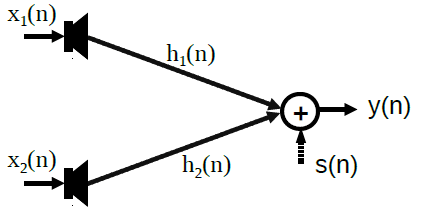Stereo or surround sound acoustic cancellation can be considered as a special case of multi-channel cancellation with a main difference: the references or speaker output signals are heavily mutually dependent. The dependence creates a troublesome problem for all Wiener filtering based cancellation algorithms: the solution is not unique.
We use the stereo music playback as the example. Below we have the left and right channels, x1(n) and x2(n), for the stereo music and a single microphone on the right. s(n) is a local sound sources.

The microphone captures the sum of the local sound, the two speakers through acoustic channel h1(n) and h2(n) respectively.
y(n) = s(n) + x1(n)h1(n) + x2(n)h2(n),
where x1(n)h1(n) and x2(n)h2(n) are the echo contributions to be removed.
The main characteristic of stereo and surround sound signals is they describe the same audio scene at the same time. The difference between each channel may be simply due to the panning. Therefore,
Δ(n) = x1(n) – x2(n),
may be significantly smaller in power compared with either the left or right channels.
We use the extreme case Δ(n) = 0 to demonstrate the non-uniqueness of the cancellation solution. We can easily see that if h1(n) and h2(n) are the pair of impulse responses that removes the echo
contribution completely,
s(n) = y(n) – x1(n)h1(n) – x2(n)h2(n),
then for any arbitrary impulse response h(n),
s(n) = y(n) – x1(n)(h1(n) + h(n)) – x2(n)(h2(n) – h(n))
and hence, the pair, h1(n) + h(n) and h2(n) – h(n), also removes the echo completely. Therefore, there exists a set of solutions that cancel the echo completely. Wiener filtering based algorithms lead to one but may not be the true solution.
For most situations the non-unique solution or a false convergence does not cause much performance degradation. However it may have noticeable and annoying artifacts when sudden changes occur in the environment. To mitigate this issue VOCAL Technologies implemented a two-rate cancellation method with a reference transformation scheme. Our approach does not totally remove the solution ambiguity but it dramatically reduces its perceptual impact.